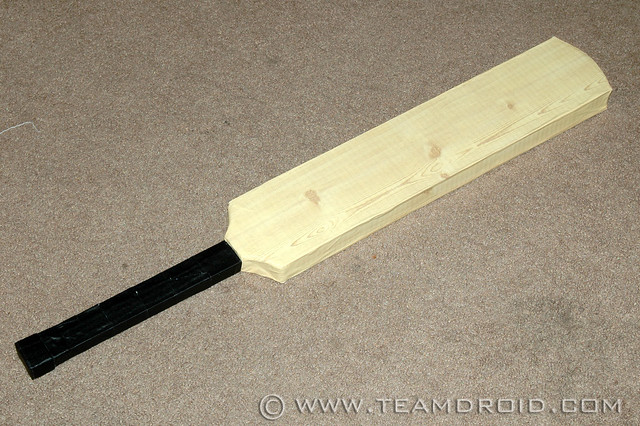Cricket is more than just a game; it's a passion that brings people together. And if you're an avid cricket fan, you know that having the right equipment is crucial. One of the most important pieces of gear is your cricket bat. Instead of heading to the store, why not unleash your creativity and make your own? In this DIY guide, we'll walk through the process of crafting your very own cricket bat, ensuring it's tailored to your needs and preferences. Grab your tools, roll up your sleeves, and let’s get started!
Materials Needed
Before diving into the actual crafting process, it’s essential to gather all the materials you’ll need. Here’s a handy list to keep you organized:
- Cricket Bat Willow: This is the primary material. Opt for high-quality English or Kashmir willow.
- Wood Glue: For bonding different parts of the bat, a strong wood glue will do the trick.
- Sandpaper: You'll need various grits (80, 120, 240) to smooth out the bat and give it a fine finish.
- Bat Mallet: This is used for knocking in the bat, making it ready for play.
- Bat Handle: You can either buy a pre-made handle or make one from wood.
- Varnish or Bat Oil: This helps protect your bat from moisture and damage.
- Clamps: Useful for holding different pieces together as the glue dries.
- Chisels and saws: For shaping the willow and handle to your desired dimensions.
Having these materials at hand will make the crafting process smoother and more enjoyable. So gather your tools, and let's prepare for some serious bat-making fun!
3. Step-by-Step Process
Creating your own cricket bat is an incredibly fulfilling project. It allows you to express your personality while also crafting a tool that fits your unique style of play. Here’s a straightforward, step-by-step approach to making your very own cricket bat:
- Gather Your Materials: You’ll need:
- High-quality willow wood
- Wood glue
- Sandpaper (various grits)
- A saw (preferably a jigsaw)
- A bat handle
- Varnish or linseed oil
- Carving tools (if you want to add personal designs)
Once completed, you’ll have a unique cricket bat tailored specifically to your preferences!
4. Caring for Your Cricket Bat
Your cricket bat is not just a piece of equipment; it's an investment. Proper care can significantly extend its lifespan and performance. Here are some basic care tips that will keep your bat in top shape:
- Oiling: Regularly oil your bat's surface. Use linseed oil to nourish the wood and help protect against moisture. A good rule of thumb is to oil your bat every 3-4 matches or once a month, depending on usage.
- Knocking-In: This is an essential process that helps to strengthen the wood fibers. Gently tap the surface of the bat with a mallet to acclimate it for hitting balls. This can take some time, so be patient!
- Store Properly: Keep your bat in a cool, dry place away from direct sunlight. Avoid storing it in damp areas, as moisture can warp the wood.
- Avoid Hard Surfaces: When practicing, avoid hitting the bat against hard surfaces like concrete or stone. Use the proper cricket ball rather than knockabout balls or hard balls.
- Check Regularly: Inspect your bat for any cracks or damage before and after use. Minor issues can often be fixed before they become major problems!
By following these simple care instructions, your homemade cricket bat will not only last longer but also perform at its best, enhancing your playing experience!
Troubleshooting Common Issues
So, you've taken the plunge and are well on your way to crafting your very own cricket bat. But what if things don't go exactly according to plan? Don’t fret! Here are some common issues you might encounter during the process, along with handy solutions to keep you on track.
- Uneven surface: If your bat has spots that feel bumpy or uneven after sanding, make sure to go back and sand those specific areas more thoroughly. Don't rush this step; you want the surface to be smooth for optimal performance.
- Too much weight: If it feels heavier than expected, consider removing some wood from the back. Be cautious though! Gradually take away material and keep checking the weight until you reach the desired balance.
- Cracks and splits: If you discover a crack in the wood, use wood glue to seal it. Clamp it down until the glue sets, and sand lightly afterward to smooth out any rough edges.
- Bad balance: An improperly balanced bat can affect your swing. To fix this, try shaving a bit more wood from the handle or the back of the bat to achieve a better weight distribution.
- Poor grip: If the grip isn't feeling right, consider re-wrapping it with sports tape or replacing it with a new grip. It should feel comfortable but secure.
Remember, making mistakes is part of the learning process. Don't hesitate to take a step back and re-evaluate your work if something feels off.
Conclusion
Crafting your own cricket bat can be a fulfilling and exciting project. Not only do you gain a sense of accomplishment, but you'll also end up with a personalized piece that reflects your style and preferences. Just imagine stepping onto the field, bat in hand, knowing you made it yourself!
Through this guide, we’ve walked you through everything from selecting the right wood to troubleshooting any hiccups along the way. Here’s a quick recap:
| Step | Description |
|---|---|
| Materials | Choosing high-quality wood like willow or poplar. |
| Design | Sketching out your preferred shape and dimensions. |
| Shaping | Sanding and cutting to achieve the desired profile. |
| Finishing | Applying oil and varnish for protection and aesthetics. |
Even if you encounter some bumps along the way, remember that each challenge is an opportunity for growth. So gather your tools, trust the process, and most importantly, have fun! Your custom cricket bat awaits; let's get swinging!











